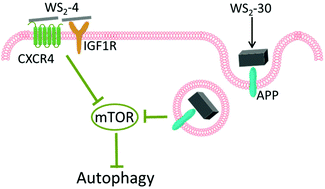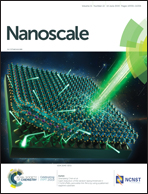Induction of mTOR-dependent autophagy by WS2 nanosheets from both inside and outside of human cells†
Abstract
The applications of two-dimensional transition metal dichalcogenides (2D TMDCs) pose an increased risk to both the environment and human health. Due to the large surface area of 2D nanosheets, they often form multi-layered nanoclusters of various thicknesses in aqueous solution. In this work, we address the safety issue of 2D TMDCs with focus on the cellular effects of the thickness of WS2 nanosheets. At a very low and non-lethal concentration (4 cm2 mL−1 or 25 μg mL−1), 4-layered WS2 nanosheets (WS2-4) were primarily bound to the cell surface with less internalization, while 30-layered WS2 nanosheets (WS2-30) were mostly internalized by human bronchial epithelial cells. Although the cellular interactions at this low concentration caused no alterations in the cell cycle, apoptosis, necrosis and cytotoxicity, cell autophagy was induced in both cases through mTOR-dependent pathways by perturbing a number of signaling molecules, such as amyloid precursor protein (APP) and cysteine-X-cysteine chemokine receptor 4 (CXCR-4). The finding of activation of cell autophagy from both outside and inside of cells reveals a novel feature of biological perturbations by 2D nanosheets. This finding will help in the formulation of general guidelines for the safe application of 2D nanomaterials.

- This article is part of the themed collection: 2019 Nanoscale HOT Article Collection


 Please wait while we load your content...
Please wait while we load your content...